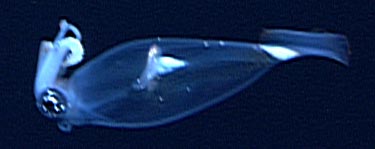Liocranchia reinhardti
Richard E. Young and Katharina M. Mangold (1922-2003)Introduction
In Hawaiian waters, this species appears to be a strong vertical migrator and may be a member of the mesopelagic boundary fauna as it seems to be more common off Hawaii over bottom depths of less than 700m than in more offshore waters (Young, 1995), however, see the following photograph. In the tropical eastern North Atlantic, however, this species has a distribution more similar to its congener.Characteristics
- Head
- Beaks: Descriptions can be found here: Lower beak; upper beak.
- Beaks: Descriptions can be found here: Lower beak; upper beak.
- Mantle
- Tubercles present along middorsal line (i.e., over gladius).
- Tubercles present along middorsal line (i.e., over gladius).
- Photophores
- 14 oval photophores on eyeball: 7 in medial series, 6 in lateral series near lens and 1 in between (see photograph).
- Large photophores on the tips of arms III in mature females.
Comments
More details of the description of L. reinhardti can be found here.Life History
L. reinhardti paralarvae in Hawaiian waters can easily be separated from paralarvae of L. valdiviae, prior to development of the dorsal tubercles, by their chromatophore pattern. Young stages can be recognized by the single large chromatophore on the ventral tip of the mantle. Larger paralarvae develop, in addition, a row of large chromatophores near the anterior end of the ventral mantle.




Figure. L. reinhardti paralarvae from Hawaiian waters. Thumbnail - Ventral views showing relative sizes of the three paralarvae. of: Left - Ventral and dorsal views, 2.9 mm ML. Middle - Ventral and dorsal views, 4.5 mm ML. Right - Ventral and dorsal views, 7.7 mm ML. Dashed lines indicate hidden chromatophores. Scale bars are 1 mm. Drawings by R. E. Young.


Figure. L. reinhardti paralarva, approximately 8-10 mm ML. Two views of the same paralarva. Left - Dorsolateral view. Right - Ventral view. Note the similarity in the chromatophore pattern to the 7.7 mm drawing above. When viewed at maximum size, the ventral mantle tubercules are barely visible. In situ photographs taken while scuba diving at 37 m depth, in open waters, Hawaii. © Jeffrey Milisen
Distribution
L. reinhardti has a cosmopolitan distribution in tropical and subtropical waters (Nesis, 1982). Off Hawaii, Reid, et al. (1991) and Young (1995) considered this squid to be a member of the mesopelagic boundary community (ie, occurring primarily over bottom depths of less than 700m) in Hawaiian waters. Bower, et at. (1999) examined the distribution of cephalopod paralarvae near Hawaii and found that L. reinhardti paralarvae to be in a group of "island associated" paralarvae belonging to species that presumably spawn nearshore. The Hawaiian data suggest that in other geographical regions, L. reinhardti may also be land-related in distribution.
References
Bower, J. R., M. P. Seki, R. E. Young, K. A. Bigelow, J. Hirota and P. Flament. 1999. Cephalopod paralarvae assemblages in Hawaiian Islands waters. Marine Ecology Progress Series, 185:203-212.
Nesis, K. N. 1982/87. Abridged key to the cephalopod mollusks of the world's ocean. 385+ii pp. Light and Food Industry Publishing House, Moscow. (In Russian.). Translated into English by B. S. Levitov, ed. by L. A. Burgess (1987), Cephalopods of the world. T. F. H. Publications, Neptune City, NJ, 351pp.
Reid, S. B., J. Hirota, R. E. Young and L. E. Hallacher. 1991. Mesopelagic-boundry community in Hawaii: micronekton at the intrface between neritic and oceanic ecosystems. Marine Biology, 109: 427-440
Voss, N. A. 1980. A generic revision of the Cranchiidae (Cephalopoda; Oegopsida). Bull. Mar. Sci. 30: 365-412.
Young, R. E. 1978. Vertical distribution and photosensitive vesicles of pelagic cephalopods from Hawaiian waters. Fish. Bull. 76: 583-615.
Young, R. E. 1995. Aspects of the natural history of pelagic cephalopods of the Hawaiian mesopelagic-boundary region. Pacific Science 49: 143-155.
About This Page

University of Hawaii, Honolulu, HI, USA
Katharina M. Mangold (1922-2003)

Laboratoire Arago, Banyuls-Sur-Mer, France
Page copyright © 2016
 Page: Tree of Life
Liocranchia reinhardti .
Authored by
Richard E. Young and Katharina M. Mangold (1922-2003).
The TEXT of this page is licensed under the
Creative Commons Attribution-NonCommercial License - Version 3.0. Note that images and other media
featured on this page are each governed by their own license, and they may or may not be available
for reuse. Click on an image or a media link to access the media data window, which provides the
relevant licensing information. For the general terms and conditions of ToL material reuse and
redistribution, please see the Tree of Life Copyright
Policies.
Page: Tree of Life
Liocranchia reinhardti .
Authored by
Richard E. Young and Katharina M. Mangold (1922-2003).
The TEXT of this page is licensed under the
Creative Commons Attribution-NonCommercial License - Version 3.0. Note that images and other media
featured on this page are each governed by their own license, and they may or may not be available
for reuse. Click on an image or a media link to access the media data window, which provides the
relevant licensing information. For the general terms and conditions of ToL material reuse and
redistribution, please see the Tree of Life Copyright
Policies.
- Content changed 16 November 2016
Citing this page:
Young, Richard E. and Katharina M. Mangold (1922-2003). 2016. Liocranchia reinhardti . Version 16 November 2016 (under construction). http://tolweb.org/Liocranchia_reinhardti/19596/2016.11.16 in The Tree of Life Web Project, http://tolweb.org/










 Go to quick links
Go to quick search
Go to navigation for this section of the ToL site
Go to detailed links for the ToL site
Go to quick links
Go to quick search
Go to navigation for this section of the ToL site
Go to detailed links for the ToL site